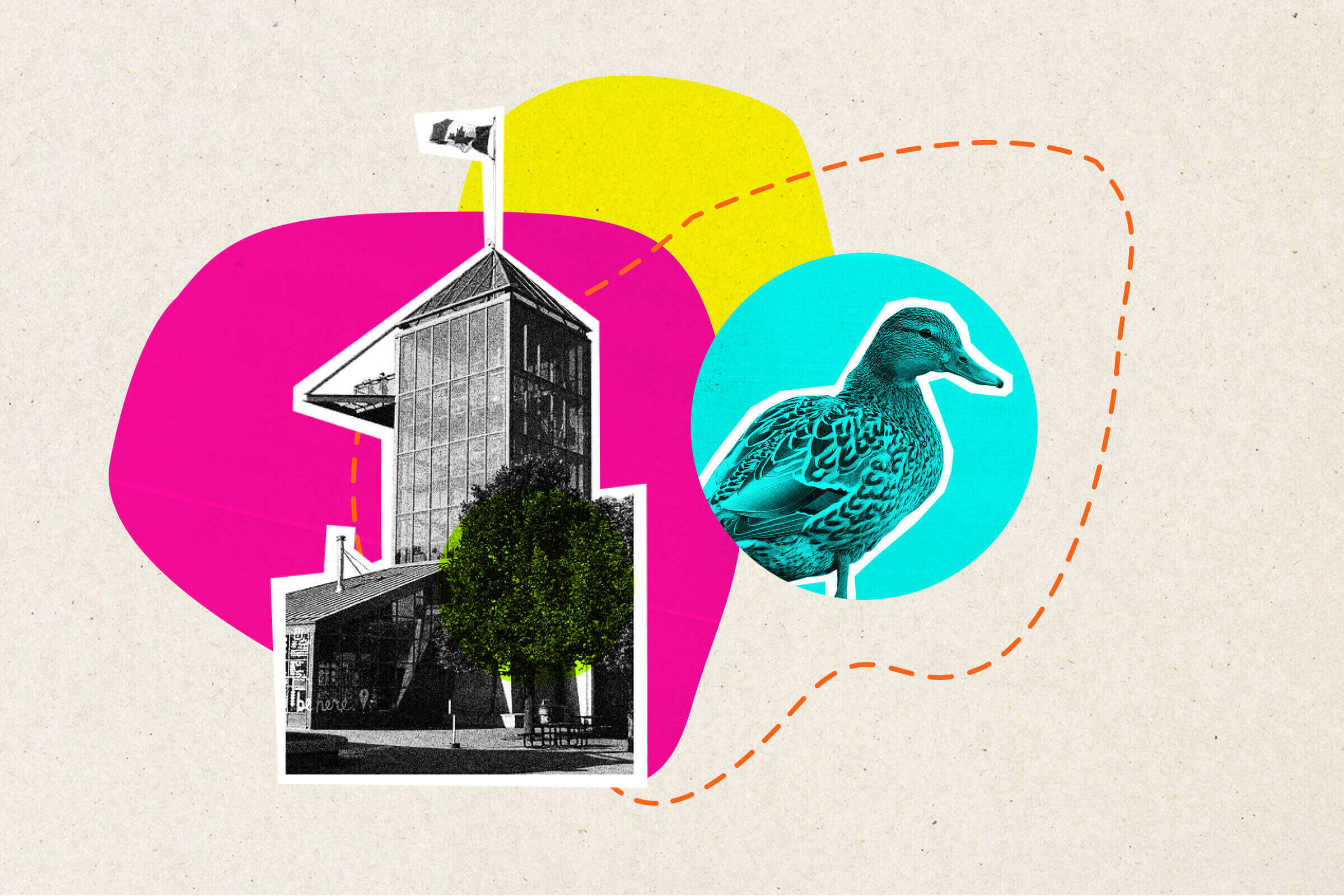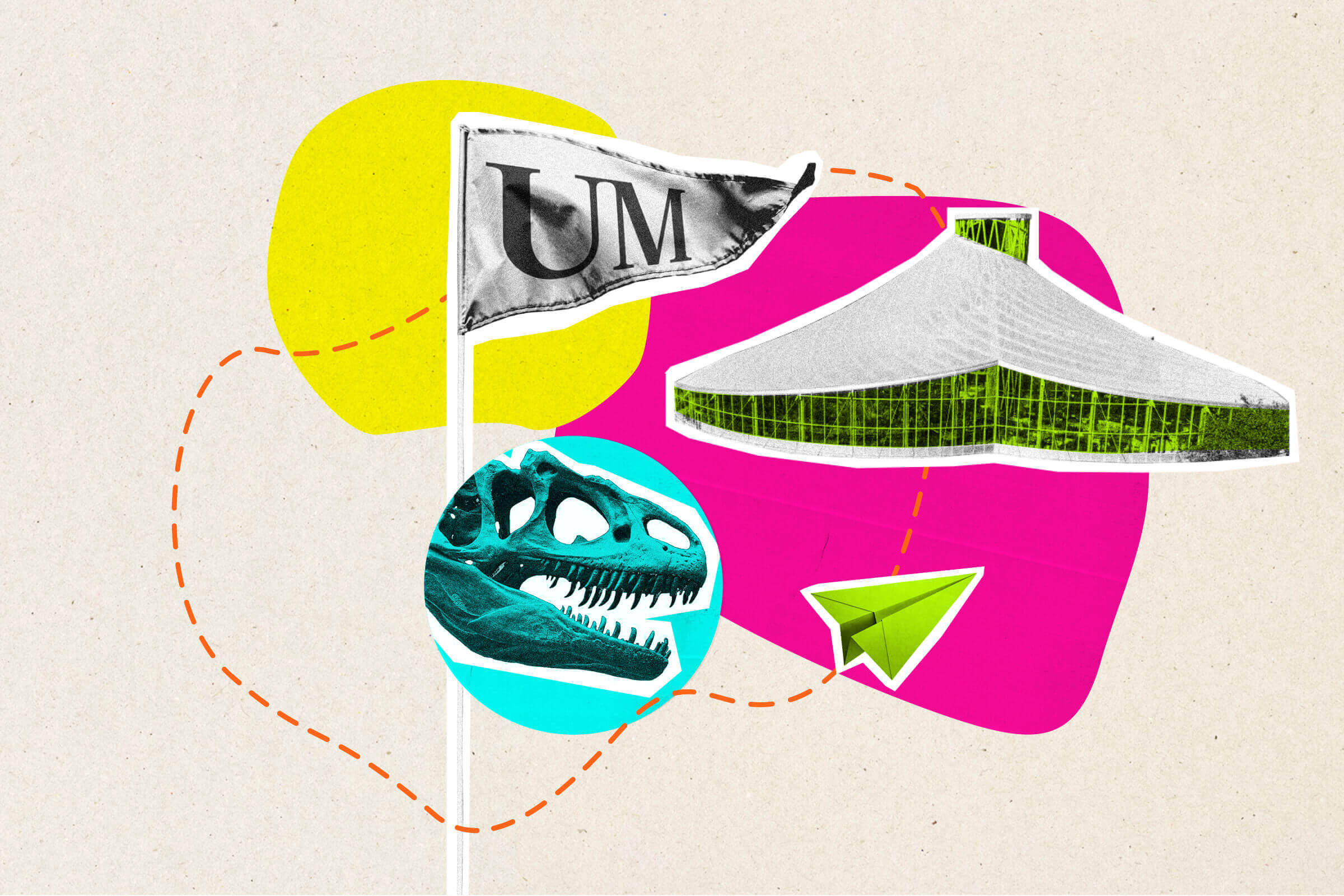The sun is out and it’s time for summer planning. Here are 10 ideas—each with a UM connection—to get you started.
1. Why not begin at one of Winnipeg’s most breathtaking spaces: The Leaf at Assiniboine Park, with its tropical air, colourful foliage, and striking new art by UM alumni.
Look for Pairidaeza, a large-scale sculpture crafted from recycled materials, among the temporary installations of the Cool Gardens public art initiative. Created by a trio of grads—Madeleine Dafoe [BEnvD/2019, MLA/2023], Yasaman Kashani [MLA/2024], and Calvin Tan [BEnvD/2018]—the eye-catching piece hangs above cozy seating in the Babs Asper Display House.
“Pairidaeza explores waste, reuse and materiality, inspired by images of ocean garbage caught in nets and by the geometric designs and symbolism of Persian carpets,” says Dafoe.
Wander through The Leaf’s four indoor biomes and expansive outdoor gardens. Between the stunning architecture, exotic plants, butterflies, and storytelling signage connecting flora to cultures around the world, the experience hits all the senses.
2. For one of the most unique summer experiences in Manitoba—maybe in all of North America—head to Morden’s Canadian Fossil Discovery Centre (CFDC). Home to Bruce, the hair-raising mosasaur and the largest marine reptile on display in the world, the CFDC also offers the chance to get your hands dirty on their popular fossil dig adventure tour.
You work side by side with actual fossil experts as they uncover the remains of a newly discovered mosasaur. UM plays a key role behind the scenes with paleontologist Kirstin Brink and sedimentologist Ricardo Silva—both from the Clayton H. Riddell Faculty of Environment, Earth, and Resources—advising the Centre’s research and revamped tour.
“We’ve had a 100 per cent success rate of finding bones since we started the dig tour,” says guide Gerry Peters, whose business card reads: Fossil Hunter.
3. Good Neighbour Brewing Co. is one of Winnipeg’s most welcoming places to grab a pint.
This proudly all-female (and 2SLGBTQ+) owned and operated West Broadway brewery was founded in 2021 by Amber Sarraillon [BPE/2005] and Morgan Wielgosz, who set out to create an awesome experience: great beer, good food, and an open-door vibe where everyone feels part of the neighbourhood.
New this year is their Brewery Backyard, the ultimate summer hangout. Think shipping container bar, cold beer slushies, games of cornhole, fishbowl cocktails, and a rotating lineup of summer brews. Food comes courtesy of their restaurant Next Door.

4. What’s the perfect summer day at The Forks? We asked the CEO at the centre of it all: Asper School of Business grad Sara Stasiuk [BComm(Hons)/97]. While shopping and dining are always solid picks, Stasiuk suggests embracing serendipity during your next visit.
“You may only be out for a walk, but then you might unexpectedly run into old friends, try a new dish or a new craft beer, see a local band, marvel at the wood ducks floating by, or get inspired by public art and the outdoors.”
Where the Red and Assiniboine Rivers meet, The Forks welcomes four million visitors yearly. This summer, there’s even more to explore with new tenants like Indigenous-owned Turtle Tours (more on that below) and Aroma Bistro, with its Hong Kong street food–inspired menu.
And what better time to visit on-site museums: kids get in free to the Canadian Museum for Human Rights with the Canada Strong Pass this summer, and the Manitoba Children’s Museum has a new exhibition, Attack of the Bloodsuckers (think ticks and mosquitoes.)
…. For those wanting to take a deeper dive into the cultural significance of The Forks—a meeting place for some 6,000 years—Niiagaan Sinclair, professor of Indigenous Studies at UM, has some recommendations.
The previously-mentioned Turtle Tours offers immersive guided walking tours on Saturdays and Sundays. Or for an experience at your own pace, download the audio guide narrated by Sinclair himself, which blends stories from Elders, landscape architects, historians and artists into an hour-long self-guided tour.
A can’t-miss site is the Oodena Celebration Circle, a sunken, amphitheatre-like gathering space designed for ceremony and reflection.
5. Manitoba’s Interlake is a goldmine of stories—just ask naturalist Heather Hinam [BSc(Hons)/98, MSc/2001] who has worked on many an interpretive sign to bring this history to life.
She suggests heading up Highway 9 to Gimli, where a large mural at the Lake Winnipeg Visitor Centre introduces the watershed and recounts the tragic sinking of the Suzanne-E in 1965, Lake Winnipeg’s worst nautical disaster. The ship went down during a sudden storm about four kilometres north of Grindstone Point, claiming nine lives.
In the harbour, keep an eye out for the Namao, a research vessel collecting water samples throughout the summer, with UM researchers aboard to better understand the health of Lake Winnipeg.
Travel west to Fraserwood to learn about the Ukrainian and Polish immigrants who founded the village. Up the road in Meleb, near the statue of three wild mushrooms, you’ll find interpretive panels detailing the area’s history—much of it drawn from the memories of a local nonagenarian who shared vivid stories from her childhood with Hinam.
“She told me stories about trapping rabbits on her way to school when she was 6 or 7 years old, and how her parents would put hot wheat into her boots to keep her feet warm in the winter.”
Finally, head south to Inwood to discover the natural history of red-sided garter snakes. The coolest part? Between May and September, you can find actual snakes slithering near the large snake statue.
6. Art-lovers looking for an experience that feels fresh and thought-provoking should stop by Winnipeg’s Graffiti Gallery before Aug. 25 to catch Emergence, a group show featuring six recent grads from UM’s School of Art.
The exhibition showcases work by Sydney Caldwell [BFA/2025], Colleen Simard [BFA/2025], Sharyn Gutierrez [BFA/2025], Mae Desmond [BFA/2025], Margot Morrish [BA/83, MEd/98, BFA(Hons)/2025], and Maria Martin [BFA/2025], exploring themes including identity and consumer culture through painting, mixed media and digital art.
Set in a vibrant space in Winnipeg’s core, Graffiti Gallery is part of a community-driven movement that uses art for social change and youth empowerment.
While you’re in an art-viewing mood, pop into WAG-Qaumajuq to see a major retrospective of acclaimed sculptor Abraham Anghik Ruben. The exhibition features more than 100 works spanning five decades. UM campus visitors will know Ruben’s work from his powerful bronze sculpture Shaman and Sedna, which stands outside Migizii Agamik.
7. A self-guided walking tour developed by the UM’s Master of Human Rights program offers a fascinating way to explore the city’s human rights story.
The map takes you to key landmarks like Louis Riel’s grave in St. Boniface, the Gandhi statue outside the Canadian Museum for Human Rights, and a residential schools monument at The Forks.
“Participants are not only informed about historical events but are also introduced to ongoing human rights initiatives and potential future developments,” says Nathan Derejko, Mauro Chair in Human Rights and Social Justice.
Download the tour map, and keep the conversation going around justice, equity and reconciliation.

8. Families looking for a fun, hands-on outing should head to the Bruce D. Campbell Farm and Food Discovery Centre at UM’s Glenlea Research Station, just a half hour south of Winnipeg.
The centre offers an interactive way to explore the story of food from farm to table, blending UM agricultural research with kid-friendly exhibits, including windows into a live pig barn. For a more immersive visit, consider booking a guided tour. With a bit of luck, you might even time your trip with the arrival of new piglets in the pig barn.
9. Mark your calendar for the Bisons Block Party on Sept. 20, a Homecoming weekend highlight and a full-on celebration of Bison spirit that’s free and open to all. There will be live music, fun activities and plenty of energy as Billy the Bison celebrates the big 4-0. The festivities cap off with the highly-anticipated game against the Alberta Golden Bears at Princess Auto Stadium.
Bisons football is forever a quintessential UM experience, and this year’s season is shaping up to be another classic. The team’s season home opener takes place Sept. 13 against long-time rivals the Saskatchewan Huskies.
Homecoming runs Sept. 18–20 with events across campus, including concerts, tours, a soccer game, and an inspiring speaker series. And don’t forget, UM alumni can claim up to four free tickets to all Bisons sports home games. So break out your brown and gold!
10. Before you pack away your runners for the season, consider taking some meaningful steps toward reconciliation by joining the Reconciliation Run on Sept. 27.
Founded by Tréchelle Bunn [BA(Hons)/23], Chief of Birdtail Sioux Dakota Nation and a 2025 UM Distinguished Alumni Award recipient, the run takes the path her grandfather once wished he could take—away from the Birtle Indian Residential School. It’s a powerful act of remembrance and healing.
This year’s event begins with a ceremony at 8:15 a.m., followed by a timed half marathon or untimed run/walk at 9 a.m. The route starts at the ruins of the residential school and ends in Birdtail Sioux Dakota Nation, where a community gathering and feast will cap off the day.
Bunn, a former Bisons hockey player and current law student at Robson Hall, launched the run as a legacy project. Since 2024, proceeds have helped establish UM’s first scholarship for Indigenous student-athletes. For many, it’s become an important fixture on the calendar.
“When I started the Reconciliation Run, I had no idea how big it could become and how many different ways it could have a positive impact on others,” Bunn told UM Today.
This summer, let us know if you spot UM on your adventures. Share with us by tagging @umanitoba on Instagram







